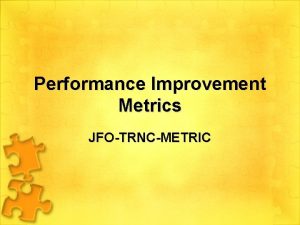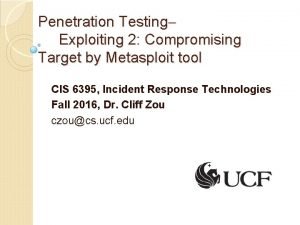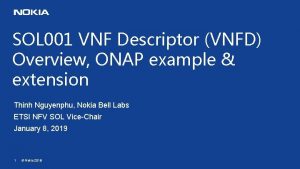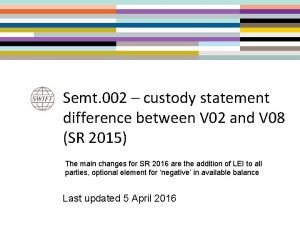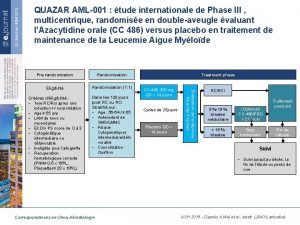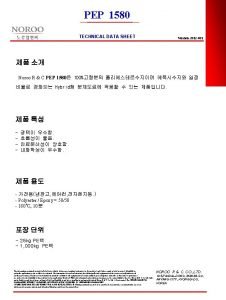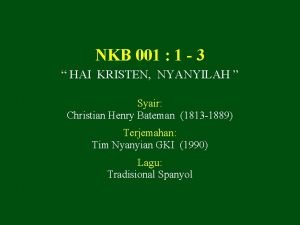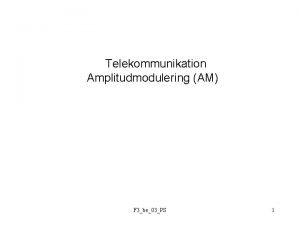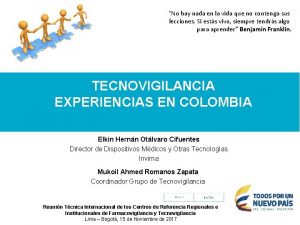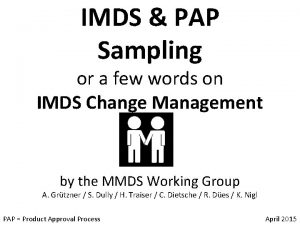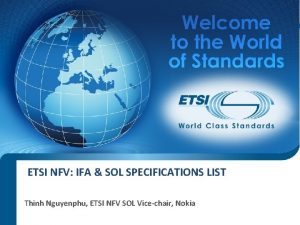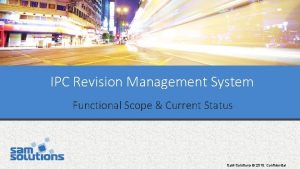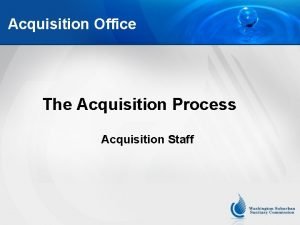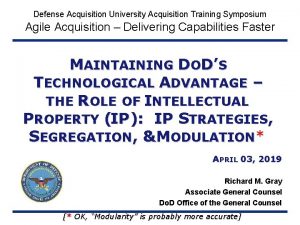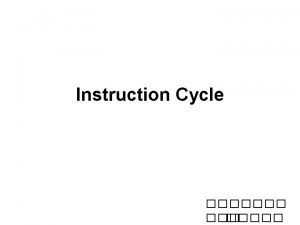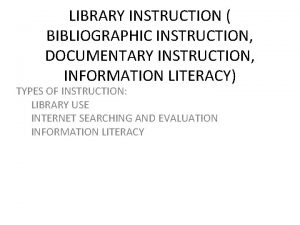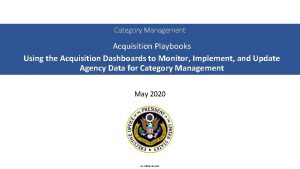Acquisition Management Instruction 102 01 001 Revision 1















































- Slides: 47

Acquisition Management Instruction 102 -01 -001, Revision 1 Overview March 2016

Acquisition Management instruction 102 -01 -001 • Supports Acquisition Management Direction, 102 -01, defining how the Department manages/oversees acquisition programs – Explains the acquisition lifecycle and provides the basis for acquisition planning and execution – Defines the acquisition review process and Acquisition Review Board (ARB) – Provides guidance for successful program planning, management, and execution (cost, schedule and performance) – Provides acquisition oversight roles and responsibilities for the CAO, CAE, CIO, CFO, CPO, PARM, Policy, CRSO, S&T/Office of Test & Evaluation, Program Managers and other key stakeholders Office of Program Accountability and Risk Management 2

Key Policy Updates • • • Scope: Programs from pre-ADE 1 through FOC, Component Heads responsible for Post-FOC programs Incorporation of new laws, GAO/IG recommendations and Departmental oversight – Federal Information Technology Acquisition Reform Act (FITARA) – Unity of Effort – Joint requirements Council – Entrance criteria for ADEs Decision Trees added for easier use and understanding – Simple Procurement vs. Service Acquisition vs. Capital Asset Acquisition – Master Acquisition Oversight List Acquisition Documentation – New requirements: S&T and OCIO Technical Assessment – PMs submit their current PMP, RMP, & IMS to support ADEs – Updated signature tables Services @ ADE 1, 2 A, & 2 B Updated roles and responsibilities (Including CAO, ARB, CAEs, ESCs, Senior Procurement Executive (SPE)…) Updated program breach policy Comprehensive Acquisition Status Report (Programs ADE-1 – FOC) Removal of old Instruction/Guidebook Appendices – templates are stilled used and available on the PARM website, but removing them from policy allows updates. Office of Program Accountability and Risk Management 3

Simple Procurement, Services Acquisition or Capital Asset Acquisition Decision Tree *Once the type of acquisition is determined it is necessary to look at the established thresholds and special interest criteria to determine its oversight requirements. 4

Acquisition Decision Authority • The ADA is responsible for ensuring compliance with MD 102 -01 by reviewing and approving the movement of each acquisition through the phases of the acquisition lifecycle when the acquisition program meets applicable criteria. • The ADA ensures that appropriate planning, including resources, necessary to successfully execute the approved program is conducted and resources are available prior to ADE approval. • The ADA has overarching responsibility for the acquisition cost, schedule, risk, and system performance of the acquisition portfolio, and is responsible for assessing Acquisition Program Baseline (APB) breaches, directing corrective actions, and approving any revisions to the APB. Office of Program Accountability and Risk Management 5

Acquisition Decision Authorities - Acquisition *Note: The Chief Acquisition Officer (CAO) may only delegate Level 2 programs to a Component Acquisition Executive (CAE), and only if the established conditions are met. If a delegated Level 2 program is in breach ADA automatically reverts to the CAO and is not automatically re-delegated upon exiting breach. Delegations of Level 2 programs will be limited. Office of Program Accountability and Risk Management 6

Acquisition Decision Authorities - Services New: Services Programs must complete ADE-1, 2 A and 2 B. *Note: The Chief Acquisition Officer (CAO) may only delegate Level 2 programs to a Component Acquisition Executive (CAE), and only if the established conditions are met. If a delegated Level 2 program is in breach ADA automatically reverts to the CAO and is not automatically re-delegated upon exiting breach. Delegations of Level 2 programs will be limited. Office of Program Accountability and Risk Management 7

Acquisition Lifecycle Framework – With JRC POLICY JRC ARB (PARM, et al. ) The Secretary’s “Unity of Effort” initiative brings together the strategic direction and guidance of the Department, and an improved requirements development and validation process, with acquisition process, execution, and oversight to more effectively and efficiently deliver capabilities to the field. Office of Program Accountability and Risk Management 8

9

Acquisition Documentation Requirements New Requirements: • S&T and OCIO Technical Assessments resulting from S 1 memo and FITARA • Service programs required to complete ADE 1, 2 A, and 2 B Elevated from SELC: Program Manager submits their current PMP, RMP, and IMS. Component CFO - FYHSP funding Certification Office of Program Accountability and Risk Management 10

Acquisition Documentation - Approvals Each acquisition document requires certain signatures and those signatures must be obtain prior to the relevant ADE approval. The JRC “validates” requirements and requirements documents in accordance with JRC policy, rather than “approving” them. 11

Acquisition Documentation - Approvals Includes document signature requirement changes due to FITARA 12

MAOL Decision Process – Capital Assets *The MAOL contains acquisition programs and non-acquisition activities. It is divided in sections that provide greater detail on the reporting requirements of each included program. MAOL site: http: //governance. dhs. gov/arb/sitepages/maol. aspx Office of Program Accountability and Risk Management 13

MAOL Decision Process – Services MAOL site: http: //governance. dhs. gov/arb/sitepages/maol. aspx Office of Program Accountability and Risk Management 14

Certification requirements DHS Acquisition Program and Project Managers and Integrated Product/Projects Team (IPT) Leads need to be certified to a level commensurate with the responsibilities of the acquisition being managed. Certification is required within 12 months of assignment. Acquisition PMs for all DHS Level 1, 2, or 3 programs are required to have a current Federal Acquisition Certification for Program and Project Managers (FAC-P/PM) Certification and core -plus DHS Specialization Certification. Program and project managers managing major IT investments are required to have a core-plus IT Specialization Certification. Specializations may be required based upon the nature and complexity of the project or program. Certification is the formal process through which DHS certifies individuals as having met the acquisition program management functional competencies through training, education and experience to perform the duties of an acquisition professional. 15

Program Breach Policy • Breaches occur when a program either fails, or it is determined that the program will fail to meet any cost, schedule or performance threshold in an approved Acquisition Program Baseline (APB) • Applies from the program’s approval at 2 A through Full Operational Capability (FOC) delivery • CAE is responsible to ensure that the PM makes the appropriate notification to the CAO/PARM for major programs in anticipation of a breach and when a breach occurs – Via formal memorandum – Documents the timeframe for corrective action and a remediation plan Provides a schedule for updated acquisition documentation • Approval of revised APB constitutes an official program re-baseline Office of Program Accountability and Risk Management 16

Overview ARB and Other Oversight Organizations 17

DHS Acquisition Review Board (ARB) • The ARB is the departmental executive board that reviews all Level 1 and Level 2 acquisitions (unless delegated to the CAE by the CAO in writing) for executable business strategy, resources, management, accountability, and alignment to strategic initiatives and supports the ADA in determining appropriate direction for the acquisition at ADEs. The ARB conducts systematic reviews of acquisitions to ensure the acquisition programs are progressing in compliance with the approved Capability Development Plan (CDP) or APB for their current acquisition phase. ADA decisions are documented via Acquisition Decision Memoranda. The ARB is comprised of the following members: – Acquisition Decision Authority (ARB Chair), – Under Secretary for Science and Technology, – Assistant Secretary for Policy, – General Counsel, – Executive Director, PARM, – Chief Financial Officer, – Chief Information Officer, – Chief Readiness Support Officer, – Chief Procurement Officer, – Chief Human Capital Officer, – Chief Security Officer, – Director of Operational Test and Evaluation, and – The Chair (or designee) of the Joint Requirements Council. Office of Program Accountability and Risk Management 18

Chief Acquisition Officer • The CAO is selected in accordance with Title 41, U. S. C. Section 1702, and according to DHS Delegation 00701, Delegation to the Chief Acquisition Officer, is responsible for the management, administration, and oversight of the Department’s acquisitions. CAO responsibilities include the following: – Advising and assisting the head of DHS and other agency officials to ensure that the mission is achieved through the management of the agency’s acquisition activities; – Administration, implementation and oversight of the Department’s acquisition policies and procedures (Note: This does not include contracts and contracting actions for which the Chief Procurement Officer is responsible); – Managing acquisition decision-making. The CAO establishes clear lines of authority, accountability, and responsibility for acquisition decision-making and ensures that acquisition decisions are consistent with all applicable laws, regulations, and departmental policies; – Synchronizing interagency coordination and types of acquisition; – Serving as the Acquisition Decision Authority (ADA), for Level 1, Level 2, and other specified acquisitions; Office of Program Accountability and Risk Management 19

Chief Acquisition Officer (continued) – Designating Component Acquisition Executives (CAEs) in writing; – Chartering and designating the chair and membership of Executive Steering Committees (ESCs) when established for major acquisitions; – Approving major (Level 1 and Level 2) acquisition program documentation in accordance with the signature authorities provided in this instruction; – Delegating major program(s) ADA as appropriate. The CAO may delegate ADA in writing for pre-FOC programs only to the appropriate CAE, and only if the following conditions are met: • Pre-FOC Programs: – A designated CAE is in place; – The program is a Level 2 program; – The Component possesses processes and procedures for overseeing the delegated program, as well as, for Component Level 3 acquisition programs that keep with the spirit and intent of MD 102 -01 and this Instruction (Note: The major Level 2 program continues to be governed in accordance with MD 102 -01 and its implementing Instructions. ); – The CAE has adequate, dedicated staff, sufficient to provide effective oversight to the Component’s Level 3 programs, as well as the delegated program; – The program being delegated has an approved Acquisition Program Baseline (APB), and is not in breach of that APB. (Note: ADA automatically reverts back to the CAO for delegated programs that are in breach of their approved APB. ADA authority is not automatically re-delegated when the program breach is cleared. ) Office of Program Accountability and Risk Management 20

Chief Acquisition Officer (continued) – Delegating major program(s) ADA as appropriate. The CAO may delegate ADA in writing for pre-FOC programs only to the appropriate CAE, and only if the following conditions are met: • Post-FOC Programs – Oversight for Major Programs (Level 1 and Level 2) that transition to post. FOC are the responsibility of the Component Head. Oversight is conducted in accordance with Component policies and procedures , with additional guidance provided in the Acquisition Decision Memorandum, “Overseeing and Tracking Costs of Acquisition Program in Sustainment, ” dates April 20, 2015. (Note: If the post-FOC program conducts a major modernization or new/replacement acquisition that reaches the acquisition thresholds established in this Instruction or the modernization materially changes the operations of the existing program, the program will return to the appropriate acquisition lifecycle phase as determined by the CAE and Executive Director, PARM, and comply with the requirements in this Instruction. ) Office of Program Accountability and Risk Management 21

Joint Requirements Council (JRC) • The JRC Chair, in collaboration with Council members is responsible for overseeing DHS requirements generation and validation process. The JRC Chair and Council members harmonize urgent capability requirements efforts across the Department. They recommend capability priority assignments to the Deputy’s Management Action Group (DMAG) for validated requirements Note: The policies governing the JRC are defined in the JRC Directive and its related policies. Office of Program Accountability and Risk Management 22

Component Heads • • The Component Heads own acquisition portfolio(s) and are responsible and accountable for adhering to the Department’s acquisition policies and procedures to ensure the sound management, review, support, approval, and oversight of all types of acquisition within their respective organizations. The Component Heads are responsible for the oversight and tracking of programs in sustainment (e. g. , Post-FOC) throughout the operational lifecycle until eventual retirement. Office of Program Accountability and Risk Management 23

Executive Director, PARM • The PARM Executive Director is located in the U/S MGMT Office, and is established according to DHS Delegation 0704, Delegation to the Executive Director, Office of Program Accountability and Risk Management. The Executive Director, PARM is the DHS executive agent for acquisition. The Executive Director, PARM manages DHS-wide acquisition program policy, governance, and oversight. The Executive Director, PARM is responsible for: – Developing and maintaining acquisition program management policy, procedures, and guidance processes; – Monitoring the CAE structure to assess adequacy of staffing compliance with Departmental policies and instructions; – Maintaining the Master Acquisition Oversight List (MAOL) of Department acquisitions and their associated ADEs; – Reviewing major acquisitions and preparing decision-support information and analysis for the ARB (e. g. , preparation of issue papers, ARB meeting schedules and agendas, and decision memoranda for ADA decisions); – Executive agent for acquisition documentation; – Advising the Department Acquisition Career Manager (ACM) on certification standards for all acquisition program management disciplines; – Providing technical support and assistance to Department acquisitions and acquisition personnel; – Serving as the DHS acquisition executive agent, Acquisition Review Process and Acquisition Review Team coordinator, and ARB Executive Secretariat; – Approval authority on the SELC Tailoring Plan for MAOL programs; and, – Overseeing the Department’s acquisition program portfolio to monitor each investment’s cost, schedule, and performance against established baselines. Office of Program Accountability and Risk Management 24

Chief Procurement Officer • According to DHS Delegation 0702, Delegation to the Senior Procurement Executive, and DHS Delegation 0703, Delegation to the Chief Procurement Officer, the CPO exercises leadership and authority over procurement related activities. The DHS CPO is responsible for: – Providing management and oversight of the procurement function within the – – – – Department; Issuing procurement regulations, policies, and implementing instructions; Promoting the use of competition, performance based acquisitions, and small business utilization to the maximum extent practicable; Designating Heads of Contracting Activities (HCAs), contracting officers, task/delivery order ombudsmen, and the Department Competition Advocate; Managing the Homeland Security Acquisition Institute (HSAI) that provides training, professional development, career management, and certification services to DHS acquisition personnel; Supporting acquisition governance by ensuring that procurement strategies align with the intent of the Acquisition Review Board (ARB) and program objectives; Serving as the approval authority for major program (Level 1 and Level 2) acquisition plans; Overseeing and implementing the DHS Strategic Sourcing Program Office (SSPO) Office of Program Accountability and Risk Management 25

Chief Financial Officer • According to DHS Delegation 01000, Delegation for Financial Activities, the CFO exercises leadership and authority over financial management policy and programs for the entire DHS enterprise. The CFO is responsible for: – Establishing policies for, and overseeing the integration of the Planning, Programming, Budgeting and Execution (PPBE) system of DHS; – Ensuring the funding planned for the acquisition is consistent with how the funds were appropriated, and that Appropriations Laws, Anti-Deficiency Act, and other applicable laws and regulations are followed; – Reviewing, as part of the ARB, the program’s status, authorization, appropriation, obligation, expenditure of funding, and affordability in a manner that is consistent with the approved structure of the acquisition; – Evaluating the budget impacts of program breaches or delays; – Serving as the focal point within DHS for policy, process, and procedures regarding the life cycle cost estimating and analysis; – Approving major acquisition program (Level 1 and Level 2) Life Cycle Cost Estimates (LCCEs). Examining affordability through the annual resource allocation process; – Assisting Component acquisition management offices by providing guidance and support regarding cost estimating methods, modeling, and documentation; – Developing Independent Cost Estimates (ICEs) as directed by the CAO; – Advising the HSAI on the career field certification, training, and education for the cost estimating and analysis community; and – Analyzing sustainment cost of acquisition programs as part of the PPBE process. Office of Program Accountability and Risk Management 26

Chief Financial Officer (continued) • Requires funds certification for capital investments at decision events to ensure affordability and to unify appropriation account structures for comparability in resource allocation decision making – Beginning at ADE-2 A “Senior Financial Officers shall provide a statement affirming they have reviewed and validated the representation of the entire program budget resources (prior years, current year, and all future years) ensuring they are consistent with the FYHSP and all other sources of funding. ” (CFO memo , Certification of Acquisition Funding, Dec 3, 20124) – Funding certified must be consistent with the LCCE at the 50% confidence level • Designated the approval authority for Life Cycle Cost Estimates for Level 1 and Level 2 major acquisitions – LCCEs are required for all Level 1 and 2 programs at ADE 2 A, 2 B, 2 C and 3 – LCCEs should be developed IAW the DHS Cost Estimating Handbook: – http: //coe. dhs. gov/CE_A_COE/Site. Pages/Best. Practices. aspx • Program Analysis &Evaluation (PA&E) Division conducts independent analysis for and provides objective, fact-based advice on resource allocation issues and the measurement, reporting, and improvement of DHS performance. Office of Program Accountability and Risk Management 27

Chief Information Officer • According to DHS Delegation 04000, Delegation for Information Technology, the CIO exercises leadership and authority over IT portfolio governance, investment management, priorities, policies, processes, standards, guidelines, and procedures. The CIO is responsible for: – Establishing Departmental IT priorities, policies, processes, standards, guidelines, and procedures; – Member of all IT Program governance boards (ESCs and Portfolio Governance Boards); – Conducting Enterprise Architecture (EA) reviews of IT programs to ensure compliance with the Homeland Security Enterprise Architecture (HLS EA) and the DHS Enterprise Roadmap prior to final approval by the ARB and inclusion in the DHS budget submission; – Conducting Portfolio Management to identify, prioritize, and monitor IT Investments and programs to ensure that mission objectives are achieved and providing advice into capital programming and budgeting; – Managing the Capital Planning and Investment Control (CPIC) process to include OMB A-11 reporting requirements; – Assessing the current maturity of the Department’s IT portfolio management process, providing information to support decisions on eliminating duplication, and moving to shared solutions in order to maximize the return on IT investments across the portfolio; – Overseeing the IT commodity spending plans and identification of cost savings for re investment across the enterprise; – Performing OCIO Program Health Assessments in support of IT dashboard reporting for programs listed in the Master Acquisition Oversight List (MAOL) that are designated as Information Technology (IT); Office of Program Accountability and Risk Management 28

Chief Information Officer (continued) – Providing subject matter expert (SME) support and Requirements Engineering Center of Excellence (COE) support for programs as needed; – Conducting Tech. Stat Accountability Session as a face-to-face, evidence-based peer review of an IT investment or program; – Managing the IT Acquisition Review (ITAR) process to evaluate IT procurements of $2. 5 million and over for Strategic Alignment with the DHS Enterprise IT Strategy and Compliance with statues, regulations, and DHS policy; and – Exercising co-approval authority on each Systems Engineering Life Cycle (SELC) Tailoring Plan submitted by Level 1 and Level 2 IT programs. – Develop and provide to the CAO and Executive Director, PARM an IT assessment and approval for IT Programs prior to entering the Obtain Phase. Office of Program Accountability and Risk Management 29

Chief Readiness Support Officer • According to DHS Delegation 00500, Delegation for Administrative Services, the CRSO exercises leadership and authority over the Department’s asset management, real property, environmental planning and management, sustainment, safety and energy management, administrative priorities, policies, processes, standards, guidelines, and procedures; engineering; and oversight in the following areas: asset management, real property, environmental planning and management, sustainment, safety and energy management. The CRSO has the authority to establish a DHS Asset Review Board (DARB). If established, the roles and responsibilities of the DARB are established in a CRSO approved charter. The CRSO is responsible for: – Establishing the Department’s administrative priorities, policies, processes, standards, guidelines, and procedures; engineering and oversight in the following areas: logistics, lifecycle and organizational management, asset management (personal property, mobile assets (e. g. , fleet vehicles) and real property), environmental planning and management, sustainment, historic preservation and energy management; – Real property portfolio and strategic asset management planning including establishment of objectives to improve the operational utility and financial management of the agency’s inventory; and – Alignment of the agency’s real property assets so that assets are managed in a manner that is consistent with, and supportive of, the goals and objectives set forth in DHS’s strategic plans. Office of Program Accountability and Risk Management 30

Director, Operational Test & Evaluation • The DOTE exercises leadership and authority over test and evaluation policy and processes. The DOTE is responsible for: – Developing and prescribing test and evaluation policy and processes; – Providing test and evaluation oversight within the Department; – Providing an independent assessment of test and evaluation progress and status for major acquisition programs; and – Approving major acquisition program’s Test and Evaluation Master Plan (TEMP). Office of Program Accountability and Risk Management 31

DHS Acquisition Review Team (ART) • The ART is a staffing body that supports the ARB by reviewing the status of acquisitions scheduled for ARBs and by assisting with the preparation of the decisions and issues placed before the ARB. The ART is comprised of the action officers that represent the members of the ARB. The ART should make sure all staff work is completed prior to the ARB Office of Program Accountability and Risk Management 32

Component Acquisition Executive Serves as the CAO’s representative for acquisition at the Component • Designated by the Under Secretary for Management/Chief Acquisition Officer – Additional guidance on the authorities and the role of the CAE was augmented by the memorandum: “Unity of Effort Acquisition Review-Component Acquisition Executive Policy dated Sept 2, 2014” – Updated acquisition policy to include additional guidance Office of Program Accountability and Risk Management 33

Component Acquisition Executive Role The CAE has the following authorities: • • Reports directly to the Department CAO on acquisition matters. Establish and implement Acquisition Policy within their Component subject to MD 102 -01. Act as the Acquisition Decision Authority (ADA) for Level 3 programs. Act as the ADA for Level 2 programs when that authority is delegated from the CAO in writing. Review, oversee, and direct acquisition program management activities for Level 1 and Level 2 programs between ADEs. Ensure the technical approach, contracting strategy, risk, financial management, and program execution are appropriate for acquisition programs within their Component. The CAE consults with the component CFO, CIO, and HCA in the execution of this authority. Place a program into breach status, and to remove a Level 3 program from breach status. Office of Program Accountability and Risk Management 34

Component Acquisition Executive Role The CAE’s role in policy: • Managing and overseeing all Component acquisition functions and coordinating them with the contracting processes managed by the HCA, with the budget development and allocation processes managed by the appropriate CFO(s), and with the IT technical experts managed by the appropriate CIO(s); • Establishing acquisition processes within the Component and tracking the extent to which the requisite resources and support are provided to acquisition Program/Project Managers in order to ensure successful and effective acquisitions; • Aligning and managing the Component acquisition portfolio in compliance with applicable Department and Component regulations and policies consistent with our missions and strategic goals; • Assisting the CAO in developing, implementing, and evaluating acquisition policies, programs, and services by providing resources, e. g. , for integrated process teams, input, and advice; and • Working with the appropriate CIO(s) to implement acquisition practices for IT programs that complement iterative/rapid/innovative IT execution. Office of Program Accountability and Risk Management 35

Component Acquisition Executive Role The CAE’s role in Oversight: • Acting as the Key Component representative at Department Acquisition Review Board (ARB) reviews of Level 1 and Level 2 acquisitions within the Component’s portfolio. The CAE presents the acquisition Program/Program Manager to the ARB; • Executing ADA responsibilities for Component Level 3 acquisitions. The CAE is responsible for both conducting and documenting acquisition decision reviews for Level 3 and delegated acquisitions; • Executing ADA responsibilities for Component Level 2 acquisitions when designated in writing by the CAO; • Recommending Operational Test Agents and reviewing Operational Test & Evaluation reports presented by Operational Test Agents; • Vetting acquisition programs prior to any Department ARB; • Ensuring that acquisition documentation is complete and demonstrates the necessary critical thinking/planning required for successful program execution. Ensure that all documents are submitted to the Department with sufficient time to support the ARB; • Ensuring that acquisition programs remain within established baselines, and reporting when programs breach those baselines or when it is determined that a breach of those baselines will occur in the future; Office of Program Accountability and Risk Management 36

Component Acquisition Executive Role The CAE’s role in Oversight (continued): • Immediately alerting the CAO and Executive Director, PARM, of significant contract or program events such as: contract awards/terminations, and/or program breaches, etc. ; • Conducting Component Program Reviews annually, and as determined by the CAE. Coordinating with PARM and inviting representatives from the Acquisition Review Team; • Ensuring each program is led by an appropriately certified and qualified Program Manager, and that program manager is appointed through written designation or charter; Supporting, along with the appropriate HCA(s), Senior Financial Officer/CFO(s) and CIO(s), the annual program and budget review for resource allocation; • Participating in the CAE Council and review boards, as required; • Approving Cost Estimating Baseline Documents (CEBDs) for any USM directed Independent Cost Estimates to be developed by CFO; • Ensuring each program has a Lead Business Authority (LBA) designated; • Ensuring each program has a Lead Technical Authority (LTA) designated; and • Consulting with the appropriate CIO(s) on IT program oversight. Office of Program Accountability and Risk Management 37

Component Acquisition Executive Role The CAE’s role in acquisition personnel / workforce: • Designing policies and processes to ensure that the best qualified persons are selected for acquisition management positions, e. g. , acquisition program managers, in accordance with DHS Directive 064 -04; and • In accordance with DHS Directive 064 -04, ensuring acquisition personnel, other than contracting personnel, but including acquisition Program/Project Managers, meet the mandatory education, training, and experience standards established for an acquisition career level (Levels I (Entry), II (Mid), and III (Senior). Office of Program Accountability and Risk Management 38

Component Acquisition Executive Role The CAE’s role in acquisition data support: • Ensuring DHS source system data residing in the Investment Evaluation, Submission, and Tracking (INVEST) System (formerly Next Generation Periodic Reporting System and the Investment Management System), or follow-on system(s) of record, are validated and submitted in a timely manner with monthly updates for all Level 1, 2, and 3 IT programs – CAEs will be required to submit certifications twice annually that INVEST data has been reviewed and is accurate. • Ensuring timely and complete response to Congressional (and other) requests, including review and response of the Comprehensive Acquisition Status Report and its quarterly updates. Office of Program Accountability and Risk Management 39

Component Senior Financial Officer • The CSFOs validate all funding information presented to the Acquisition Review Board (and to the Component Acquisition Decision Authority for those acquisition programs which only require Component approval). CSFOs certify the acquisition program has sufficient funding throughout the five-year Future Year Homeland Security Program (FYHSP). The appropriate CSFO (or their representative) is required to participate in the DHS-level ARB Office of Program Accountability and Risk Management 40

Component Head of Contracting Activity • Component HCAs review all Acquisition Plans for Level 1 and 2 (Major) acquisitions. The HCA signs the AP as “Recommended for CPO Approval, ” in accordance with the Acquisition Planning Guide of September 2013 (or follow-on guidance if updated). HCA’s or their staff then forward the AP to the DHS CPO for final signature and approval. In the event that an AP requires no update for an ADE, follow the guidance provided in the HSAM, Acquisition Planning Guide. Office of Program Accountability and Risk Management 41

Executive Steering Committees (ESC) • ESC is a senior body of individuals that provides guidance and support to acquisitions between ADEs and provides technical direction and support in accordance with the ADA -approved ESC charter. The responsibilities and authorities of the ESC are delineated in the ESC charter, although the ADA maintains oversight and accountability for the acquisition. Note: ADE decisions and acquisition documentation approval cannot be delegated to an ESC. As ESC may be a generic term, only ESCs chartered by the CAO (or designated ADA) are recognized as acquisition ESCs. ) Office of Program Accountability and Risk Management 42

Back-up Material 43

Documentation Descriptions • • • Mission Need Statement - synopsizes at a high level specific capabilities required to accomplish the DHS and Component missions and objectives Analysis of Alternatives – provides a systematic analytic and decision making process to identify and document an optimal solution for an identified mission capability gap Capabilities Development Plan – documents the activities, cost, and schedule plan for the work to be performed in the Analyze/Select phase leading up to ADE-2 A; sets boundaries and scopes critical activities in the Analyze/Select phase Concept of Operations - describes how an asset, system, or capability will be employed and supported; bridges gap between MNS and ORD; assists in identifying and selecting balanced solutions in the Ao. A Operational Requirements Document - identifies and provides a number of performance parameters that need to be met by a program to provide useful capability to the user, thus acting to close the capability gap(s) identified in the MNS Acquisition Plan - provides a top-level plan for the overall acquisition approach and types of acquisition and a plan for acquiring future sustainment and support Acquisition Program Baseline – formally documents the program’s critical cost, schedule, and performance parameters, expressed in measurable, quantitative terms that must be met to accomplish the program’s goals Cost Estimating Baseline Document -A single, comprehensive document that defines the technical, programmatic, and schedule of a system. It provides information on development, testing, procurement, integration, installation and replacement, operations and maintenance, planned upgrades, and disposal. Serves as the basis for all LCCEs (i. e. , program and independent cost estimates (ICEs)). Life Cycle Cost Estimate - provides an accounting of all past, present, and future resources and associated cost elements required to develop, produce, deploy, sustain and dispose of a particular system (program) regardless of funding sources Office of Program Accountability and Risk Management 44

Documentation Descriptions Cont. • • • Integrated Master Schedule- Is a schedule or culmination of schedules that include all of the work required to fulfill the scope of the program Systems Engineering Life Cycle Tailoring Plan – documents a program’s development approach and the manner in which the DHS SELC Guide is applied that provides the best opportunity for delivery and meets all of the required standards for reviews, and reduces risk. Test and Evaluation Master Plan - documents the overarching T&E approach for the acquisition program throughout the program lifecycle Integrated Logistics Support Plan – describes and establishes the program’s approach to field and maintain a supportable and sustainable system through an affordable and effective support structure Program Management Plan- provides a clear understanding of the breadth and depth of the program, and how to execute against the scope to successfully achieve the mission of the program. It incorporates overviews of resource planning, program initiation documents, the Work Breakdown Structure (WBS), the Integrated Master Schedule (IMS), organizational roles & responsibilities, risk management, communications, quality assurance, cost management, staff requirements, change management and any other pertinent planning associated with a program Risk Management Plan -defines risk processes and tools that facilitate the program’s efforts to execute projects, ongoing operations, and support services successfully. Office of Program Accountability and Risk Management 45

ALF and Systems Engineering Life Cycle SELC- Systems Engineering Life Cycle Office of Program Accountability and Risk Management 46

ALF Phase Purposes Major Acquisition Lifecycle Overview Acquisition Phase Need Analyze/ Select ADE Purpose Documents 1 Document the user’s need and plan for Analyze/Select Phase 2 A Acquisition Program Baseline (APB), Lifecycle Cost Estimate (LCCE), Formally establishes the program Operational Requirements Document (ORD), to analyze appropriate methods Integrated Logistics Support Plan (ILSP), for meeting approved Acquisition Plan (AP) requirements Component Funding Certification Technology Assessment (S&T and OCIO) 2 B Plan for method of development and delivery, establishes strategy for acquisition/procurement and testing of solution APB, LCCE, ILSP, AP, Systems Engineering Lifecycle Tailoring Plan (SELC TP), Test and Evaluation Master Plan (TEMP) Component Funding Certification 2 C Low Rate Initial Production (if required) Component Funding Certification Get capability to the user & maintain it APB, LCCE, ILSP, AP, Component Funding Certification Obtain Produce/ 3 Deploy/ Support Mission Needs Statement (MNS), Capability Development Plan (CDP) Office of Program Accountability and Risk Management 47
 Revision passive voice
Revision passive voice Acquisition vs learning examples
Acquisition vs learning examples Differentiated instruction vs individualized instruction
Differentiated instruction vs individualized instruction Site:slidetodoc.com
Site:slidetodoc.com Heterojenleşme nedir
Heterojenleşme nedir How to find the critical values
How to find the critical values Förändringsfaktor
Förändringsfaktor Acad 02-001
Acad 02-001 Ms09 001 exploit
Ms09 001 exploit Nom 001
Nom 001 Numero decimal
Numero decimal H4279 001 01 - hmo
H4279 001 01 - hmo W trzech koszykach są 72 jabłka
W trzech koszykach są 72 jabłka Pyp-001
Pyp-001 Aes-001
Aes-001 110 000 110 & 111 000 111
110 000 110 & 111 000 111 Dm6443-001
Dm6443-001 Vnf descriptor
Vnf descriptor Semt.001
Semt.001 702 001 in expanded form
702 001 in expanded form 01-012
01-012 Easa cm-swceh-001
Easa cm-swceh-001 In mudra loan rs.50 001 to rs.500 000 are categorised as
In mudra loan rs.50 001 to rs.500 000 are categorised as Auec2-004
Auec2-004 Ip-eng-001
Ip-eng-001 How many significant figures are in 3,000,001
How many significant figures are in 3,000,001 Sys_user_has_role
Sys_user_has_role Kj 001
Kj 001 Pyp 001 kfupm
Pyp 001 kfupm 001 002 003
001 002 003 Ices-001 issue 5
Ices-001 issue 5 Aml 001
Aml 001 Pep-001
Pep-001 Ankb 001
Ankb 001 Bandbredd
Bandbredd 101100112
101100112 Eventos adversos en salud
Eventos adversos en salud Nbn d51-003
Nbn d51-003 Imds rec 001
Imds rec 001 Zeeker 001
Zeeker 001 Norsok z-001
Norsok z-001 Wm-001
Wm-001 Dr lukas graf
Dr lukas graf Simulatietool zelfredzaamheid
Simulatietool zelfredzaamheid Etsi gr nfv-ifa 029
Etsi gr nfv-ifa 029 001 002 003
001 002 003 Revision management system
Revision management system Rasic chart
Rasic chart







